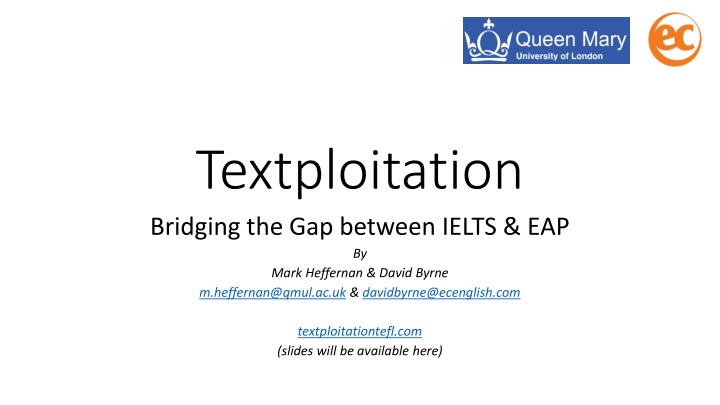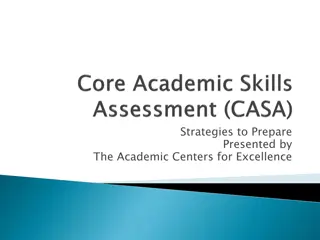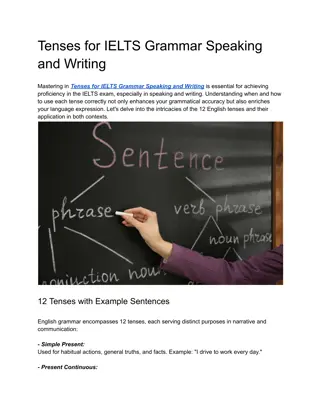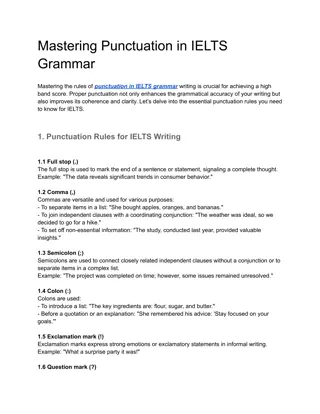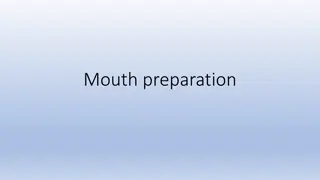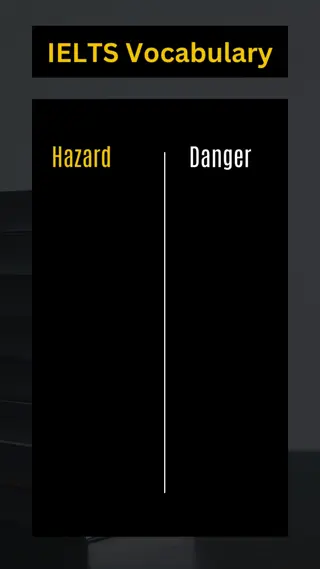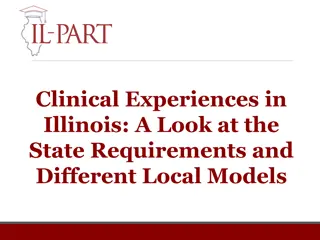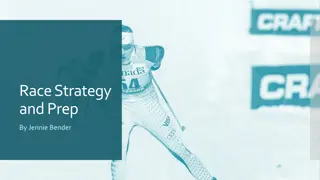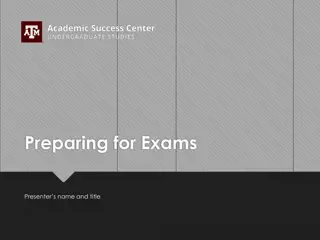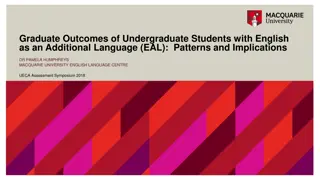Enhancing IELTS Preparation through Textploitation Approach
Empowering educators with tools to transform IELTS preparation by encouraging a text-based teaching approach that fosters critical reading, writing, and research skills essential for success beyond the exam. The innovative Textploitation method challenges traditional narratives, promotes active student engagement, and brings university-level skills into focus.
Download Presentation

Please find below an Image/Link to download the presentation.
The content on the website is provided AS IS for your information and personal use only. It may not be sold, licensed, or shared on other websites without obtaining consent from the author.If you encounter any issues during the download, it is possible that the publisher has removed the file from their server.
You are allowed to download the files provided on this website for personal or commercial use, subject to the condition that they are used lawfully. All files are the property of their respective owners.
The content on the website is provided AS IS for your information and personal use only. It may not be sold, licensed, or shared on other websites without obtaining consent from the author.
E N D
Presentation Transcript
Textploitation Bridging the Gap between IELTS & EAP By Mark Heffernan & David Byrne m.heffernan@qmul.ac.uk & davidbyrne@ecenglish.com textploitationtefl.com (slides will be available here)
It encourages you to return to a text after an activity. It suggests a little and often approach. It assumes there is more to be exploited in a text What is Textploitation? It believes skills & systems can be taught from a text. It encourages an overt approach to teaching
Aims: To discuss & challenge the current narrative surrounding IELTS. To encourage you to reframe the exam/course for your students. To give you the tools to do so.
How do your students see the IELTS exam / course? How do you talk about it with your students?
Ugh, gonna need some help changing this narrative
Once pertinent content has been identified, specific paragraphs will be read in detail Intensive reading So we re teaching real reading & research strategies and not just how to get through the exam. Prior to reading, assumptions have been made regarding content. Reading confirms or challenges those assumptions Prediction What are the main IELTS reading skills? Texts need to be seen as a whole in order to identify where key information might be. Surveying At university, large texts need to be skimmed and scanned to check relevance. Skimming & Scanning
At university, your answer matters. So we re actually preparing them for university writing. These skills are relevant beyond the exam. Coherence: Answering the question At university, this is no longer a thing. Showing range What are the main IELTS writing skills? No longer a way of losing points, it s now a way to avoid plagiarism and summarising is a key strategy. Paraphrasing / summarising Cohesion: organization & linking Linking moves from something that shows range to something that holds a text together. Structuring an argument, actually summarising in the conclusion, referencing well.
Lets take stock: what are we saying / not saying? We are not saying: - You re teaching IELTS wrong. - You should be bringing in university texts or expecting university- standard writing. We are saying: - Our students are taking IELTS in order to prepare themselves for university. - The exam tests (to some extent) the main academic skills they will need. - Our students don t necessarily realise this. They see it as a means to an end. - By changing how we talk about the skills and putting the focus on their future, we can engage them. - By exploiting your IELTS texts further, you can better prepare them for the challenges ahead.
It encourages you to return to a text after an activity. It assumes there is more to be exploited in a text It suggests little and often What is Textploitation? It encourages an overt approach to teaching It believes skills & systems can be taught from a text.
What's so funny? Task: John McCrone reviews recent research on humour The joke comes over the headphones: ' Which side of a dog has the most hair? The left.' No, not funny. Try again. ' Which side of a dog has the most hair? The outside.' Hah! The punchline is silly yet fitting, tempting a smile, even a laugh. Laughter has always struck people as deeply mysterious, perhaps pointless. The writer Arthur Koestler dubbed it the luxury reflex: 'unique in that it serves no apparent biological purpose'. Read this IELTS reading section. 1) What skills would you highlight? 2) How would you bridge them with EAP? 3) What could you point out that could help them with their academic writing? Theories about humour have an ancient pedigree. Plato expressed the idea that humour is simply a delighted feeling of superiority over others. Kant and Freud felt that joke-telling relies on building up a psychic tension which is safely punctured by the ludicrousness of the punchline. But most modern humour theorists have settled on some version of Aristotle's belief that jokes are based on a reaction to or resolution of incongruity, when the punchline is either a nonsense or, though appearing silly, has a clever second meaning. Graeme Ritchie, a computational linguist in Edinburgh, studies the linguistic structure of jokes in order to understand not only humour but language understanding and reasoning in machines. He says that while there is no single format for jokes, many revolve around a sudden and surprising conceptual shift. A comedian will present a situation followed by an unexpected interpretation that is also apt. So even if a punchline sounds silly, the listener can see there is a clever semantic fit and that sudden mental 'Aha!' is the buzz that makes us laugh. Viewed from this angle, humour is just a form of creative insight, a sudden leap to a new perspective. However, there is another type of laughter, the laughter of social appeasement and it is important to understand this too. Play is a crucial part of development in most young mammals. Rats produce ultrasonic squeaks to prevent their scuffles turning nasty. Chimpanzees have a 'play-face' - a gaping expression accompanied by a panting 'ah, ah' noise. In humans, these signals have mutated into smiles and laughs. Researchers believe social situations, rather than cognitive events such as jokes, trigger these instinctual markers of play or appeasement. People laugh on fairground rides or when tickled to flag a play situation, whether they feel amused or not. Both social and cognitive types of laughter tap into the same expressive machinery in our brains, the emotion and motor circuits that produce smiles and excited vocalisations. However, if cognitive laughter is the product of more general thought processes, it should result from more expansive brain activity.
Which bits did you skim? Did you scan for key words? Read intensively? Reading Skills What's so funny? John McCrone reviews recent research on humour The joke comes over the headphones: ' Which side of a dog has the most hair? The left.' No, not funny. Try again. ' Which side of a dog has the most hair? The outside.' Hah! The punchline is silly yet fitting, tempting a smile, even a laugh. Laughter has always struck people as deeply mysterious, perhaps pointless. The writer Arthur Koestler dubbed it the luxury reflex: 'unique in that it serves no apparent biological purpose'. How did you approach reading this article? Theories about humour have an ancient pedigree. Plato expressed the idea that humour is simply a delighted feeling of superiority over others. Kant and Freud felt that joke-telling relies on building up a psychic tension which is safely punctured by the ludicrousness of the punchline. But most modern humour theorists have settled on some version of Aristotle's belief that jokes are based on a reaction to or resolution of incongruity, when the punchline is either a nonsense or, though appearing silly, has a clever second meaning. Why did you approach it in that way? Graeme Ritchie, a computational linguist in Edinburgh, studies the linguistic structure of jokes in order to understand not only humour but language understanding and reasoning in machines. He says that while there is no single format for jokes, many revolve around a sudden and surprising conceptual shift. A comedian will present a situation followed by an unexpected interpretation that is also apt. How well did it work for you? So even if a punchline sounds silly, the listener can see there is a clever semantic fit and that sudden mental 'Aha!' is the buzz that makes us laugh. Viewed from this angle, humour is just a form of creative insight, a sudden leap to a new perspective. When will you use this skill in university? However, there is another type of laughter, the laughter of social appeasement and it is important to understand this too. Play is a crucial part of development in most young mammals. Rats produce ultrasonic squeaks to prevent their scuffles turning nasty. Chimpanzees have a 'play-face' - a gaping expression accompanied by a panting 'ah, ah' noise. In humans, these signals have mutated into smiles and laughs. Researchers believe social situations, rather than cognitive events such as jokes, trigger these instinctual markers of play or appeasement. People laugh on fairground rides or when tickled to flag a play situation, whether they feel amused or not. Why are we practicing this skill? Why have we taught it? Why are we asking you to apply it? Both social and cognitive types of laughter tap into the same expressive machinery in our brains, the emotion and motor circuits that produce smiles and excited vocalisations. However, if cognitive laughter is the product of more general thought processes, it should result from more expansive brain activity.
Writing Skills What's so funny? John McCrone reviews recent research on humour The joke comes over the headphones: ' Which side of a dog has the most hair? The left.' No, not funny. Try again. ' Which side of a dog has the most hair? The outside.' Hah! The punchline is silly yet fitting, tempting a smile, even a laugh. Laughter has always struck people as deeply mysterious, perhaps pointless. The writer Arthur Koestler dubbed it the luxury reflex: 'unique in that it serves no apparent biological purpose'. Consider actual cohesion in the paragraph Theories about humour have an ancient pedigree. Plato expressed the idea that humour is simply a delighted feeling of superiority over others. Kant and Freud felt that joke-telling relies on building up a psychic tension which is safely punctured by the ludicrousness of the punchline. But most modern humour theorists have settled on some version of Aristotle's belief that jokes are based on a reaction to or resolution of incongruity, when the punchline is either a nonsense or, though appearing silly, has a clever second meaning. Choose a single paragraph to focus on What linking is actually present? Graeme Ritchie, a computational linguist in Edinburgh, studies the linguistic structure of jokes in order to understand not only humour but language understanding and reasoning in machines. He says that while there is no single format for jokes, many revolve around a sudden and surprising conceptual shift. A comedian will present a situation followed by an unexpected interpretation that is also apt. What is the function of each sentence? So even if a punchline sounds silly, the listener can see there is a clever semantic fit and that sudden mental 'Aha!' is the buzz that makes us laugh. Viewed from this angle, humour is just a form of creative insight, a sudden leap to a new perspective. Topic sentence / claim / evidence / counter / analysis / conclusion / bridge to next paragraph or link to prior? However, there is another type of laughter, the laughter of social appeasement and it is important to understand this too. Play is a crucial part of development in most young mammals. Rats produce ultrasonic squeaks to prevent their scuffles turning nasty. Chimpanzees have a 'play-face' - a gaping expression accompanied by a panting 'ah, ah' noise. In humans, these signals have mutated into smiles and laughs. Researchers believe social situations, rather than cognitive events such as jokes, trigger these instinctual markers of play or appeasement. People laugh on fairground rides or when tickled to flag a play situation, whether they feel amused or not. Both social and cognitive types of laughter tap into the same expressive machinery in our brains, the emotion and motor circuits that produce smiles and excited vocalisations. However, if cognitive laughter is the product of more general thought processes, it should result from more expansive brain activity.
Vocabulary Building What's so funny? John McCrone reviews recent research on humour The joke comes over the headphones: ' Which side of a dog has the most hair? The left.' No, not funny. Try again. ' Which side of a dog has the most hair? The outside.' Hah! The punchline is silly yet fitting, tempting a smile, even a laugh. Laughter has always struck people as deeply mysterious, perhaps pointless. The writer Arthur Koestler dubbed it the luxury reflex: 'unique in that it serves no apparent biological purpose'. Theories about humour have an ancient pedigree. Plato expressed the idea that humour is simply a delighted feeling of superiority over others. Kant and Freud felt that joke-telling relies on building up a psychic tension which is safely punctured by the ludicrousness of the punchline. But most modern humour theorists have settled on some version of Aristotle's belief that jokes are based on a reaction to or resolution of incongruity, when the punchline is either a nonsense or, though appearing silly, has a clever second meaning. Return to a text and identify lexical fields for topic / argument building etc. Give them the language they need to discuss the functions. Topic sentence, etc. Graeme Ritchie, a computational linguist in Edinburgh, studies the linguistic structure of jokes in order to understand not only humour but language understanding and reasoning in machines. He says that while there is no single format for jokes, many revolve around a sudden and surprising conceptual shift. A comedian will present a situation followed by an unexpected interpretation that is also apt. So even if a punchline sounds silly, the listener can see there is a clever semantic fit and that sudden mental 'Aha!' is the buzz that makes us laugh. Viewed from this angle, humour is just a form of creative insight, a sudden leap to a new perspective. When will this be useful for you? However, there is another type of laughter, the laughter of social appeasement and it is important to understand this too. Play is a crucial part of development in most young mammals. Rats produce ultrasonic squeaks to prevent their scuffles turning nasty. Chimpanzees have a 'play-face' - a gaping expression accompanied by a panting 'ah, ah' noise. In humans, these signals have mutated into smiles and laughs. Researchers believe social situations, rather than cognitive events such as jokes, trigger these instinctual markers of play or appeasement. People laugh on fairground rides or when tickled to flag a play situation, whether they feel amused or not. Both social and cognitive types of laughter tap into the same expressive machinery in our brains, the emotion and motor circuits that produce smiles and excited vocalisations. However, if cognitive laughter is the product of more general thought processes, it should result from more expansive brain activity.
Critical Thinking What's so funny? John McCrone reviews recent research on humour The joke comes over the headphones: ' Which side of a dog has the most hair? The left.' No, not funny. Try again. ' Which side of a dog has the most hair? The outside.' Hah! The punchline is silly yet fitting, tempting a smile, even a laugh. Laughter has always struck people as deeply mysterious, perhaps pointless. The writer Arthur Koestler dubbed it the luxury reflex: 'unique in that it serves no apparent biological purpose'. These texts are full of people and opinions. Not technically assessed in IELTS Theories about humour have an ancient pedigree. Plato expressed the idea that humour is simply a delighted feeling of superiority over others. Kant and Freud felt that joke-telling relies on building up a psychic tension which is safely punctured by the ludicrousness of the punchline. But most modern humour theorists have settled on some version of Aristotle's belief that jokes are based on a reaction to or resolution of incongruity, when the punchline is either a nonsense or, though appearing silly, has a clever second meaning. Would there be value in: 1) Googling them to learn more? 2) Considering their bias? 3) Summarising their opinions and evaluating them? 4) Discussing writer opinion? But crucial at university level worth developing? Graeme Ritchie, a computational linguist in Edinburgh, studies the linguistic structure of jokes in order to understand not only humour but language understanding and reasoning in machines. He says that while there is no single format for jokes, many revolve around a sudden and surprising conceptual shift. A comedian will present a situation followed by an unexpected interpretation that is also apt. So even if a punchline sounds silly, the listener can see there is a clever semantic fit and that sudden mental 'Aha!' is the buzz that makes us laugh. Viewed from this angle, humour is just a form of creative insight, a sudden leap to a new perspective. However, there is another type of laughter, the laughter of social appeasement and it is important to understand this too. Play is a crucial part of development in most young mammals. Rats produce ultrasonic squeaks to prevent their scuffles turning nasty. Chimpanzees have a 'play-face' - a gaping expression accompanied by a panting 'ah, ah' noise. In humans, these signals have mutated into smiles and laughs. Researchers believe social situations, rather than cognitive events such as jokes, trigger these instinctual markers of play or appeasement. People laugh on fairground rides or when tickled to flag a play situation, whether they feel amused or not. Both social and cognitive types of laughter tap into the same expressive machinery in our brains, the emotion and motor circuits that produce smiles and excited vocalisations. However, if cognitive laughter is the product of more general thought processes, it should result from more expansive brain activity.
Mark Heffernan & David Byrne m.heffernan@qmul.ac.uk & davidbyrne@ecenglish.com textploitationtefl.com (slides will be available here)
